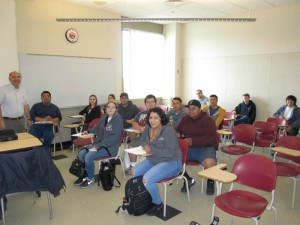
Photo: Hagop Ohanessian
Staff Report
Prof. Barlow Der Mugrdechian has been teaching an Armenian history survey course at Fresno State for more than thirty years. This semester twenty-three students are enrolled in the Armenian Studies 108B-Modern Armenian History course, which is a survey of Armenian history from the fall of the Armenian Kingdom of Cilicia to the establishment of the Modern Armenian Republic.
The Armenian History course is a requirement for students planning to complete a Minor in Armenian Studies. For History majors, the course fulfills the World Regions Field of the History Department.
This year’s students are enthusiastic to learn about the experiences of the Armenian people as they faced a variety of challenges. Class participation has been high with students engaging with Prof. Der Mugrdechian in discussions highlighting the often complex problems Armenians faced.
Many of the students were intrigued to learn about the Armenian Genocide. History major Paul Dinh thought learning about the Genocide was the most interesting part of the course. “An important theme that I have learned is that one group of people’s hatred towards another group can cause them to conduct terrible crimes.” For Anna Nelson learning more about the Genocide in comparison to the Holocaust was what caught her interest.
History major Mercedes Martinez felt the course was important because “it shed light on a history that is not well known.”
Some of the students who are taking the course for a Minor, have learned more about the Armenian people. “Classes like this are important so that students can get an insight on important historical events not taught in other classes,” said Alica Yegiazaryan.
“I liked the class discussions about different topics which have helped me understand the material better,” said Christine Idjian, who is minoring in Armenian Studies.
Many of the history majors in the course enjoyed learning about the Armenians. “Classes like this are important because the Armenian people have had a major influence in the world. It was interesting to get a different perspective about a culture and its traditions,” said Vivian Zavala.
Arthur Pena-Flatray was impressed by the fact that Armenians “were able to maintain their identities despite constant invasions and threats.” Sometime students enroll in the class because it is a requirement, as in the case of Thomas Scarr, but “it has become my favorite class.”
“I believe these classes are important because educating non-Armenians about the past spreads the word about the Armenian culture and history,” said Arlen Pilavian.
 Hye Sharzhoom Armenian Action
Hye Sharzhoom Armenian Action